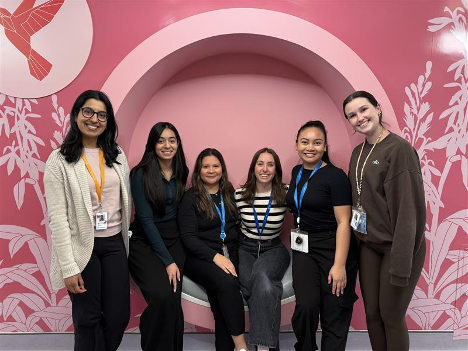Madison Billings, OT Reg. (Ont.)1; Aliya Satani, OT Reg. (Ont.)1; Anna Murray, OT Reg. (Ont.)1; Christine Cambas, OT Reg. (Ont.)1; Evelyn Smart, OT Reg. (Ont.)1; Sarah Murli, OT Reg. (Ont.)1; Janicka Auguste, CDA1
1Grandview Kids, Durham Region, Ontario, Canada; Research@grandviewkids.ca

Aliya Satani, Anna Murray, Christine Cambas, Evelyn Smart, Madison Billings and Sarah Murli are part of the Grandview School-Years Occupational Therapy team. They serve children with sensory, cognitive and physical differences in schools across the Durham region. Within their role, they identify students’ strengths and barriers that impact learning and participation. They recommend strategies for skill development, equipment and environmental modifications, with an overarching goal of helping kids access meaningful learning and play.
Emails: madison.billings@grandviewkids.ca, aliya.satani@grandviewkids.ca, anna.murray@grandviewkids.ca, christine.cambas@grandviewkids.ca, evelyn.smart@grandviewkids.ca, sarah.murli@grandviewkids.ca.
Despite its widespread use in schools, sensory rooms and equipment lack strong evidence, leaving OTs without clear best practice guidelines.
INTRODUCTION
In school settings, sensory rooms are designed to support regulation, behaviour, and learning by providing controlled sensory input—vestibular, proprioceptive, tactile, visual, and auditory. These spaces can benefit both sensory-seeking and sensory-avoidant students through tools such as swings, weighted items, fidgets, and calming lighting. From a school-based OT perspective, however, there is limited consensus on best practices for how sensory rooms should be designed, implemented, and integrated into the school day to ensure interventions are individualized, evidence-based, and effective in supporting participation and classroom success.
Aim: The purpose of this review was to explore the literature on sensory rooms in schools to determine whether best practice guidelines exist for occupational therapy implementation.
METHODS
Database Search: Conducted across EBSCOhost (CINAHL, ERIC, PsycINFO), PubMed, and Scopus.
What are the best practices for designing and using a sensory room for neurodivergent children in an elementary school setting?
SEARCH TERMS
- Sensory Room / Multi-Sensory Environments
- sensory room*
- multi-sensory environment* OR MSE*
- Snoezelen
- sensory space*
- sensory break*
- controlled sensory input
- Comfort room
B. Population / Setting
- school* OR classroom* OR “educational setting*”
- student* OR child* OR adolescent*
- pediatric OR youth
C. Intervention / Profession
- “occupational therapy” OR OT
- “sensory-based intervention*” OR SBI
D. Outcomes / Focus
- self-regulation OR regulation
- engagement OR participation
- behaviour* OR “classroom behaviour”
- attention OR “on-task behaviour”
RESULTS
Inclusion Criteria
- Peer-reviewed studies (2000–2025)
- Interventions involving sensory rooms or MSEs
- Neurodiverse population
Exclusion Criteria:
- Interventions, including Ayres Sensory Integration (ASI)
- Mental health/psych
- Medical intervention
- Adult population
- Full article unavailable to access
Screening Process:
- 149 initial articles identified
- 29 full texts reviewed
- 12 studies included in final synthesis
Themes that emerged from the literature:
- Lack of evidence and research for sensory rooms
- Relationship between the individual person, their environment and occupational considerations impact the effectiveness of sensory input.
- Need for training for caregivers involved
- Moderate evidence for the effectiveness of proprioceptive input.
DISCUSSION
Findings across the literature:
- Lack of conclusive evidence on best practices for sensory room design, staff training, and general sensory interventions.
- Despite the popularity of sensory interventions, many are not universally supported by research.
Key Challenges:
- Inconsistent Labels – Sensory rooms, calming rooms, quiet spaces, multi-modal space, etc.
- Different Uses – Structured routines vs. unstructured breaktime, proactive vs. reactive use, movement vs. calm.
- Unequal Resources – Some schools well-equipped, other shave limited tools, school budget varies, staffing.
- Varied Space & Access – Ranges from large rooms to small closets; availability depends on school size.
- Lack of Staff Training – Inconsistent understanding of sensory needs and how to use the space, staff turnover.
Call for Future Research
- Long-term effects of sensory room use on regulation and participation at school.
- Development of guidelines for sensory room design and usage across schools.
- Exploratory research: Defining sensory rooms in the context of schools
- A need for more empirical research to identify which sensory tools and environments are most effective for different students.
